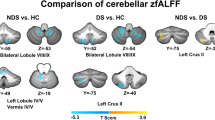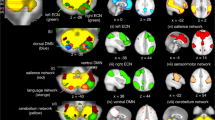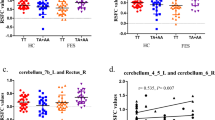Abstract
In addition to the role of planning and executing movement, the cerebellum greatly contributes to cognitive process. Numerous studies have reported structural and functional abnormalities in the cerebellum for HIV-infected patients, but little is known about the altered functional connectivity of particular cerebellar subregions and the cerebrum. Therefore, this study aimed to explore the resting-state functional connectivity (rsFC) changes of the cerebellum and further analyze the relationship between the rsFC changes and the neuropsychological evaluation. The experiment involved 26 HIV-infected men with asymptomatic neurocognitive impairment (ANI) and 28 healthy controls (HC). We selected bilateral hemispheric lobule VI and lobule IX as seed regions and mapped the whole-brain rsFC for each subregion. Results revealed that right lobule VI showed significant increased rsFC with the anterior cingulate cortex (ACC) in HIV-infected subjects. In addition, the correlation analysis on HIV-infected subjects illustrated the increased rsFC was negatively correlated with the attention/working memory score. Moreover, significantly increased cerebellar rsFCs were also observed in HIV-infected patients related to right inferior frontal gyrus (IFG) and right superior medial gyrus (SMG) while decreased rsFC was just found between right lobule VI and the left hippocampus (HIP). These findings suggested that, abnormalities of cerebro-cerebellar functional connectivity might be associated with cognitive dysfunction in HIV-infected men, particularly working memory impairment. It could also be the underlying mechanism of ANI, providing further evidence for early injury in the neural substrate of HIV-infected patients.





Similar content being viewed by others
References
Allen LS, Gorski RA (1992) Sexual orientation and the size of the anterior commissure in the human brain. Proc Natl Acad Sci 89:7199–7202
Andrews-Hanna JR, Smallwood J, Spreng RN (2014) The default network and self-generated thought: component processes, dynamic control, and clinical relevance. Ann N Y Acad Sci 1316:29–52
Ann HW, Jun S, Shin NY, Han S, Ahn JY, Ahn MY, Jeon YD, Jung IY, Kim MH, Jeong WY, Ku NS, Kim JM, Smith DM, Choi JY (2016) Characteristics of resting-state functional connectivity in HIV-associated neurocognitive disorder. PLoS One 11:e0153493
Antinori A, Arendt G, Becker J, Brew B, Byrd D, Cherner M, Clifford D, Cinque P, Epstein L, Goodkin K (2007) Updated research nosology for HIV-associated neurocognitive disorders. Neurology 69:1789–1799
Baddeley A (1996) Exploring the central executive. Q J Exp Psychol A Hum Exp Psychol 49:5–28
Caldwell JZ, Gongvatana A, Navia BA, Sweet LH, Tashima K, Ding M, Cohen RA (2014) Neural dysregulation during a working memory task in human immunodeficiency virus-seropositive and hepatitis C coinfected individuals. J Neuro-Oncol 20:398–411
Castelo J, Sherman S, Courtney M, Melrose R, Stern C (2006) Altered hippocampal-prefrontal activation in HIV patients during episodic memory encoding. Neurology 66:1688–1695
Chang L, Løhaugen G, Douet V, Miller E, Skranes J, Ernst T (2016) Neural correlates of working memory training in HIV patients: study protocol for a randomized controlled trial. Trials 17:62
Chang L, Speck O, Miller EN, Braun J, Jovicich J, Koch C, Itti L, Ernst T (2001) Neural correlates of attention and working memory deficits in HIV patients. Neurology 57:1001–1007
Chen SHA, Ho MHR, Desmond JE (2014) A meta-analysis of cerebellar contributions to higher cognition from PET and fMRI studies. Hum Brain Mapp 35:593–615
Cooper DW (1958) The physiology and pathology of the cerebellum. Yale J Biol Med 31:108
Corrêa DG, Zimmermann N, Ventura N, Tukamoto G, Doring T, Leite SC, Fonseca RP, Bahia PR, Lopes FC, Gasparetto EL (2017) Longitudinal evaluation of resting-state connectivity, white matter integrity and cortical thickness in stable HIV infection: preliminary results. Neuroradiol J 30:535–545
Cox RW, Chen G, Glen DR, Reynolds RC, Taylor PA (2017) FMRI clustering in AFNI: false-positive rates redux. Brain Connect 7:152–171
Desmond JE, Chen S, Shieh PB (2005) Cerebellar transcranial magnetic stimulation impairs verbal working memory. Ann Neurol 58:553–560
Desmond JE, Fiez JA (1998) Neuroimaging studies of the cerebellum: language, learning and memory. Trends Cogn Sci 2:355–362
Diedrichsen J (2006) A spatially unbiased atlas template of the human cerebellum. NeuroImage 33:127–138
Elsheikh BH, Maher WE, Kissel JT (2010) Cerebellar atrophy associated with human immunodeficiency virus infection. Arch Neurol 67:634–635
Ernst T, Chang L, Jovicich J, Ames N, Arnold S (2002) Abnormal brain activation on functional MRI in cognitively asymptomatic HIV patients. Neurology 59:1343–1349
Ernst T, Yakupov R, Nakama H, Crocket G, Cole M, Watters M, Ricardo-Dukelow ML, Chang L (2009) Declined neural efficiency in cognitively stable human immunodeficiency virus patients. Ann Neurol 65:316–325
Fletcher P, McKenna P, Friston K, Frith C, Dolan R (1999) Abnormal cingulate modulation of fronto-temporal connectivity in schizophrenia. NeuroImage 9:337–342
Fling BW, Cohen RG, Mancini M, Carpenter SD, Fair DA, Nutt JG, Horak FB (2014) Functional reorganization of the locomotor network in Parkinson patients with freezing of gait. PLoS One 9:e100291
Gardini S, Venneri A, Sambataro F, Cuetos F, Fasano F, Marchi M, Crisi G, Caffarra P (2015) Increased functional connectivity in the default mode network in mild cognitive impairment: a maladaptive compensatory mechanism associated with poor semantic memory performance. J Alzheimers Dis 45:457–470
Grant I, Franklin DR, Deutsch R, Woods SP, Vaida F, Ellis RJ, Letendre SL, Marcotte TD, Atkinson J, Collier AC (2014) Asymptomatic HIV-associated neurocognitive impairment increases risk for symptomatic decline. Neurology 82:2055–2062
Greicius MD, Krasnow B, Reiss AL, Menon V (2003) Functional connectivity in the resting brain: a network analysis of the default mode hypothesis. Proc Natl Acad Sci 100:253–258
Guha A, Wang L, Tanenbaum A, Esmaeili-Firidouni P, Wendelken LA, Busovaca E, Clifford K, Desai A, Ances BM, Valcour V (2016) Intrinsic network connectivity abnormalities in HIV-infected individuals over age 60. J Neurovirol 22:80–87
Guo W, Liu F, Zhang Z, Liu G, Liu J, Yu L, Xiao C, Zhao J (2015) Increased cerebellar functional connectivity with the default-mode network in unaffected siblings of schizophrenia patients at rest. Schizophr Bull 41:1317–1325
Habas C, Kamdar N, Nguyen D, Prater K, Beckmann CF, Menon V, Greicius MD (2009) Distinct cerebellar contributions to intrinsic connectivity networks. J Neurosci 29:8586–8594
Hakkers CS, Arends JE, Barth RE, Du Plessis S, Hoepelman AI, Vink M (2017) Review of functional MRI in HIV: effects of aging and medication. J Neuro-Oncol 23:20–32
Hawellek DJ, Hipp JF, Lewis CM, Corbetta M, Engel AK (2011) Increased functional connectivity indicates the severity of cognitive impairment in multiple sclerosis. Proc Natl Acad Sci 108:19066–19071
Heaton RK, Grant I, Butters N, White DA, Kirson D, Atkinson JH, McCutchan JA, Taylor MJ, Kelly MD, Ellis RJ, Wolfson T, Velin R, Marcotte TD, Hesselink JR, Jernigan TL, Chandler J, Wallace M, Abramson I (2009) The HNRC 500-neuropsychology of HIV infection at different disease stages. J Int Neuropsychol Soc 1:231
Keren-Happuch E, Chen S-HA, Ho M-HR, Desmond JE (2014) A meta-analysis of cerebellar contributions to higher cognition from PET and fMRI studies. Hum Brain Mapp 35:593–615
Kipping JA, Grodd W, Kumar V, Taubert M, Villringer A, Margulies DS (2013) Overlapping and parallel cerebello-cerebral networks contributing to sensorimotor control: an intrinsic functional connectivity study. NeuroImage 83:837–848
Kirschen MP, Chen SA, Schraedley-Desmond P, Desmond JE (2005) Load-and practice-dependent increases in cerebro-cerebellar activation in verbal working memory: an fMRI study. NeuroImage 24:462–472
Law WA, Martin A, Mapou RL, Roller TL, Salazar AM, Temoshok LR, Rundell JR (1994) Working memory in individuals with HIV infection. J Clin Exp Neuropsychol 16:173–182
LeVay S (1991) A difference in hypothalamic structure between heterosexual and homosexual men. Science 253:1034–1037
Luks TL, Simpson GV, Feiwell RJ, Miller WL (2002) Evidence for anterior cingulate cortex involvement in monitoring preparatory attentional set. NeuroImage 17:792–802
Marcotte TD, Ghate M, Deutsch R, Letendre S, Meyer RA, Godbole, Risbud A, Thakar M, Grant I, Mehendale S (2012) Earlier initiation of antiretroviral therapy results in better neurocognitive functioning. In: Paper presented at the 19th conference on retroviruses and opportunistic infections, Seattle, WA, March 5-8. http://www.natap.org/2012/CROI/croi_155.htm
Meoded A, Morrissette AE, Katipally R, Schanz O, Gotts SJ, Floeter MK (2015) Cerebro-cerebellar connectivity is increased in primary lateral sclerosis. NeuroImage: Clinical 7:288–296
Middleton F, Strick P (1994) Anatomical evidence for cerebellar and basal ganglia involvement in higher cognitive function. Science 266:458–461
Onuki Y, Van Someren EJ, De Zeeuw CI, Van der Werf YD (2013) Hippocampal–cerebellar interaction during spatio-temporal prediction. Cereb Cortex 25:313–321
Osaka M, Osaka N, Kondo H, Morishita M, Fukuyama H, Aso T, Shibasaki H (2003) The neural basis of individual differences in working memory capacity: an fMRI study. NeuroImage 18:789–797
Heaton RK, Clifford M, Franklin J, Woods P, Ake P, Vaida P, Ellis M, Letendre M, Marcotte P, Atkinson M, Rivera-Mindt P, Vigil M, Taylor P, Collier M, Marra M, Gelman M, McArthur M, Morgello M, Simpson M, McCutchan M, Abramson P, Gamst P, Fennema-Notestine P, Jernigan P, Wong M, Grant M, For the CHARTER Group (2010) HIV-associated neurocognitive disorders persist in the era of potent antiretroviral therapy. Neurology 75(23):2087–2096
Raichle ME, MacLeod AM, Snyder AZ, Powers WJ, Gusnard DA, Shulman GL (2001) A default mode of brain function. Proc Natl Acad Sci 98:676–682
Reyes E, Mohar A, Mallory M, Miller A, Masliah E (1994) Hippocampal involvement associated with human immunodeficiency virus encephalitis in Mexico. Arch Pathol Lab Med 118:1130–1134
Riedel MC, Ray KL, Dick AS, Sutherland MT, Hernandez Z, Fox PM, Eickhoff SB, Fox PT, Laird AR (2015) Meta-analytic connectivity and behavioral parcellation of the human cerebellum. NeuroImage 117:327–342
Rochefort C, Arabo A, André M, Poucet B, Save E, Rondi-Reig L (2011) Cerebellum shapes hippocampal spatial code. Science 334:385–389
Sang L, Qin W, Liu Y, Han W, Zhang Y, Jiang T, Yu C (2012) Resting-state functional connectivity of the vermal and hemispheric subregions of the cerebellum with both the cerebral cortical networks and subcortical structures. NeuroImage 61:1213–1225
Savic I, Lindström P (2008) PET and MRI show differences in cerebral asymmetry and functional connectivity between homo-and heterosexual subjects. Proc Natl Acad Sci 105:9403–9408
Schmahmann JD (1991) An emerging concept: the cerebellar contribution to higher function. Arch Neurol 48:1178–1187
Smith EE, Jonides J (1999) Storage and executive processes in the frontal lobes. Science 283:1657–1661
Stoodley CJ, Schmahmann JD (2009) Functional topography in the human cerebellum: a meta-analysis of neuroimaging studies. NeuroImage 44:489–501
Stout JC, Salmon D, Butters N, Taylor M, Peavy G, Heindel W, Delis D, Ryan L, Atkinson J, Chandler J (1995) Decline in working memory associated with HIV infection. Psychol Med 25:1221–1232
Sundermann B, Pfleiderer B (2012) Functional connectivity profile of the human inferior frontal junction: involvement in a cognitive control network. BMC Neurosci 13:119
Swaab DF, Hofman MA (1990) An enlarged suprachiasmatic nucleus in homosexual men. Brain Res 537:141–148
Tagliati M, Simpson D, Morgello S, Clifford D, Schwartz R, Berger J (1998) Cerebellar degeneration associated with human immunodeficiency virus infection. Neurology 50:244–251
Thomas JB, Brier MR, Snyder AZ, Vaida FF, Ances BM (2013) Pathways to neurodegeneration effects of HIV and aging on resting-state functional connectivity. Neurology 80:1186–1193
Wagner MJ, Kim TH, Savall J, Schnitzer MJ, Luo L (2017) Cerebellar granule cells encode the expectation of reward. Nature 544:96–100
Wang L, Zou F, Shao Y, Ye E, Jin X, Tan S, Hu D, Yang Z (2014) Disruptive changes of cerebellar functional connectivity with the default mode network in schizophrenia. Schizophr Res 160:67–72
Wiley CA, Soontornniyomkij V, Radhakrishnan L, Masliah E, Mellors J, Hermann SA, Dailey P, Achim CL (1998) Distribution of brain HIV load in AIDS. Brain Pathol 8:277–284
Woods SP, Moore DJ, Weber E, Grant I (2009) Cognitive neuropsychology of HIV-associated neurocognitive disorders. Neuropsychol Rev 19:152–168
Yu W, Krook-Magnuson E (2015) Cognitive collaborations: bidirectional functional connectivity between the cerebellum and the hippocampus. Front Syst Neurosci 9:177
Zheng W, Liu X, Song H, Li K, Wang Z (2017) Altered functional connectivity of cognitive-related cerebellar subregions in Alzheimer’s disease. Front Aging Neurosci 9:143
Zhuo C, Wang C, Wang L, Guo X, Xu Q, Liu Y, Zhu J (2017) Altered resting-state functional connectivity of the cerebellum in schizophrenia. Brain Imaging Behav 12(2):383–389
Funding
This study was supported by the Fundamental Research Funds for the Central Universities (WK 2100230016 to XW), the National Natural Science Foundation of China (91432301), the National Natural Science Foundation of China (81701665), the National Nature Science Foundation of China (81571634, 81771806), the Beijing Municipal Administration of Hospitals Incubating Program (PX2016036), the Beijing Municipal Administration of Hospitals Clinical Medicine Development of Special Funding (No. ZYLX201511), and the Capital Medical University Research and Incubation Funding (PYZ2017124).
Author information
Authors and Affiliations
Corresponding authors
Ethics declarations
All procedures performed in the studies involving human participants were in accordance with the ethical standards of the research ethics committee of the Beijing Youan Hospital, Capital Medical University, and with the 1964 Helsinki declaration and its later amendments or comparable ethical standards.
Conflict of interest
The authors declare that they have no conflict of interest.
Informed consent
Informed consent was obtained from all individual participants included in the study.
Rights and permissions
About this article
Cite this article
Wang, H., Li, R., Zhou, Y. et al. Altered cerebro-cerebellum resting-state functional connectivity in HIV-infected male patients. J. Neurovirol. 24, 587–596 (2018). https://doi.org/10.1007/s13365-018-0649-x
Received:
Revised:
Accepted:
Published:
Issue Date:
DOI: https://doi.org/10.1007/s13365-018-0649-x




